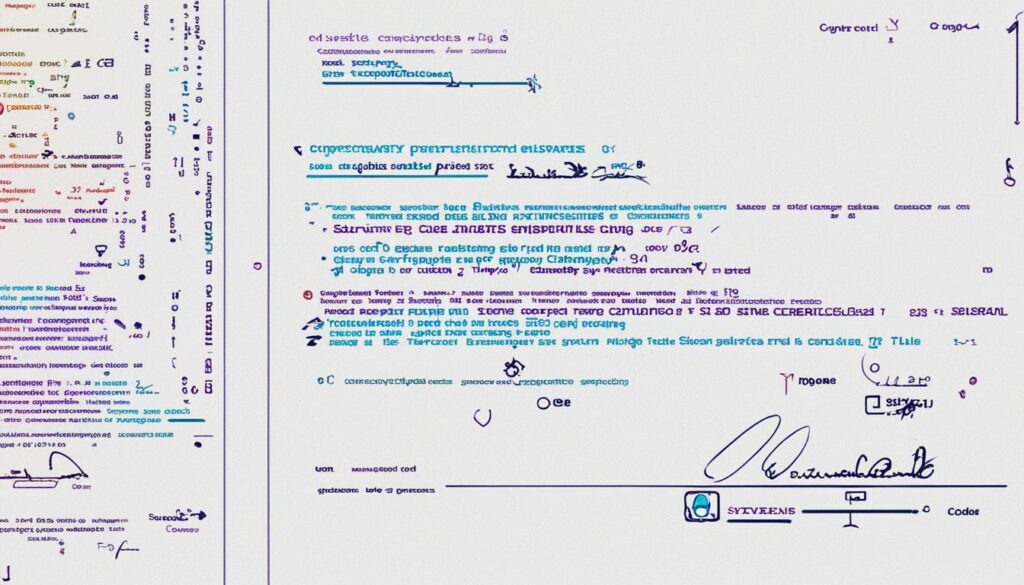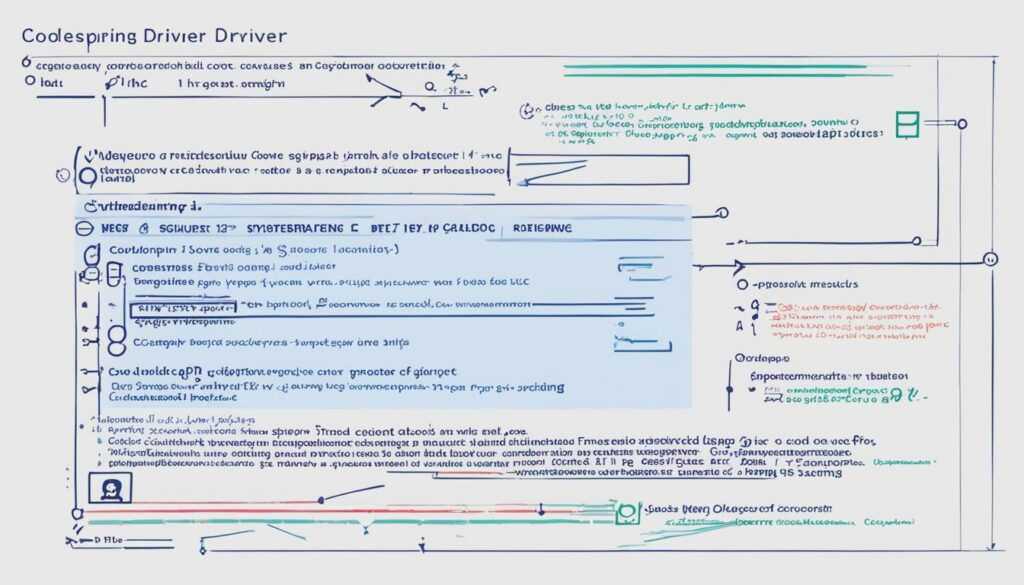In the realm of digital security, a staggering 99% of computers are estimated to be vulnerable to software supply chain attacks. Companies and developers must take exhaustive measures to ensure the integrity and long-term legitimacy of their digital assets. Understanding timestamping in code signing is not just a technical formality; it is an essential practice that can make or break the secure deployment and ongoing reputation of software applications. As we explore this topic, we uncover the pivotal role that digital signature timestamps play in protecting the long-term validity of code, thereby securing not just applications, but also the trust of users around the globe.
Key Takeaways
- Comprehending the role of timestamping in code signing is critical for mitigating the risk of future code integrity challenges.
- Digital signature timestamps ensure that software remains verified, even if the code signing certificate expires, upholding secure digital assets.
- Long-term validity of code signatures is maintained through the reliable process of timestamping, which endows software with a durable trust seal.
- With continual advancements in malware tactics, the use of Enhanced Validation certificates and robust timestamping mechanisms has become more crucial than ever.
- Successful implementation of timestamping allows for the preservation of a software’s reputation in an environment replete with security threats.
Introduction to Code Signing and Its Significance
At its core, code signing certificates serve as a digital seal of authenticity and integrity for software, providing software insurance that instills trust among users. Code signing ascertains that the software consumers download or execute comes directly from the stated source and has not been altered or compromised since the time of signing. This certification process is pivotal for maintaining the integrity of software, ensuring it remains untainted by unauthorized modifications—a critical consideration in today’s security-conscious digital landscape.
Code signing best practices require that every piece of code is uniquely signed, turning the software development industry into a bastion of trust. When an executable or a script is signed through this process, it confirms the software’s origin by a trusted entity, which is validated on execution. If the code’s sanctity has been preserved, the result maintains the sterling reputation of its creators and extends confidence to its users.
To illustrate the significance of code signing and its role in safeguarding software, let’s examine the fundamental steps of this indispensable security practice:
- Initial conversion of the executable file into a binary format
- Creation of a cryptographic hash of this binary content
- Application of the digital signature that envelopes the cryptographic hash and all relevant certificates
- Verification of the signature’s integrity when the file is executed
This verification plays out during the execution process, where the operating system rehashes the binary file and juxtaposes it with the original hash contained within the signing certificate. A match confirms the authenticity of the software, embodying the essence of code signing as a commitment to software insurance and integrity.
| Aspect of Code Signing | Significance | Best Practice |
|---|---|---|
| Certificate Source | Ensures legitimacy of software origin | Obtain certificates from reputable Certificate Authorities |
| Integrity Check | Confirms code remains unaltered | Regularly rehash and validate signature against certificates |
| User Trust | Increases consumer confidence in software safety | Communicate and display signing information transparently |
| Security Assurance | Signifies code has not been tampered with | Embed comprehensive digital signatures |
The responsibility lies with both software developers and consumers to understand the mechanisms that fortify software authenticity. For developers, it remains imperative to adhere to code signing protocols, while users need to recognize the importance of seeking signed software for their personal and organizational use. Only through a combined vigilance can we ensure that software retains its intended reliability and function as a secure component of our digital toolkit.

Understanding the Role of Timestamping in Code Signing
In the field of software security, the timestamping process in code signing stands as a hallmark of authenticity and enduring trust. This practice ensures that a code’s digital signature remains acknowledged as legitimate long after the certificate’s prescribed validity has expired. Let’s delve into the significance of timestamping and how it reinforces the integrity and reliability of digital signatures.
What Is Timestamping and Why It Matters
Timestamping acts much like a seal that definitively records the date and time a digital signature was applied to the code. It’s an immutable proof that signing was completed while the certificate was still valid. Considering that code signing certificates are not perpetual, the timestamping importance in code signing cannot be overstated. It continues to vouch for the code’s authenticity past the expiration date of the signing certificate, a vital factor for software distributed over long periods.

Ensuring Longevity of Digital Signatures with Timestamps
The rationale behind employing timestamps extends beyond simply notating a signature’s date; it’s about preserving the software’s credibility. Imagine the hurdles users and developers would face if each time a certificate expired, the software’s signature became invalid, potentially flagging it as untrustworthy or malicious. Timestamp servers utilizing protocols like Authenticode or RFC3161 ensure digital longevity. In many ways, the timestamping benefits in code signing are akin to a library’s embosser—signing its name on literature to symbolize perpetual knowledge.
When it comes to EV code signing certificates, timestamping is not just beneficial; it’s imperative. Such certificates meet the highest validation standards required today, and timestamping solidifies their validity over extended periods which can be critical for high-stakes environments.
Developers must engage in timestamping best practices to guarantee that their applications, drivers, or software continue to be trusted by operating systems, security software, and users. By employing timestamping, developers weave a chronicle of security into the lifecycle of their code, assuring stakeholders that what is signed today will remain verified tomorrow.
The Mechanics Behind Code Signing with Timestamps
The code signing process is a fundamental cornerstone in maintaining the integrity of executables. It’s a detailed procedure that involves several critical steps to ensure that when a user runs a piece of software, its authenticity is verified, and its code is proven to be untampered with. Central to this process is the creation of a digital signature, a complex interaction involving hashing, encryption, and the implementation of timestamps.
Underpinning the security offered by this system is hashing. This acts as a digital fingerprint of the software’s code. During the signing phase, an algorithm processes the software and produces a hash value, a string of characters that uniquely identifies the contents of the application. If even a single bit of the software is changed after this process, the hash value would also change, alerting to potential tampering.
Once hashed, the data is encrypted with the developer’s private key which then forms the digital signature. This signature, alongside the public key provided by the developer, is what users and systems use to verify the integrity of the executables during the signature verification phase. When the software is executed, the system will decrypt the signature with the public key, recompute the hash of the code, and compare it to the original hash stored in the signature. If they match, the software is confirmed as authentic and unchanged.
However, what if the code signing certificate, which is inherently tied to the validity of the software, expires? That’s where timestamping becomes invaluable. By marking the signed code with a timestamp when the signature was applied, the integrity and trustworthiness of the software are preserved even after the original certificate has expired. This temporal marker validates that the software was signed while the certificate was still valid.
Let’s review the process visually with a simplified look at the steps involved when an executable file is signed with a timestamp:
| Step | Action | Component | Purpose |
|---|---|---|---|
| 1 | Hashing the Code | Hash Function | Creating a unique digital fingerprint of the executable. |
| 2 | Encrypting the Hash | Private Key | Generating the digital signature. |
| 3 | Applying the Timestamp | Timestamp Server | Marking the signature with a time to establish when it was made. |
| 4 | Signature Verification | Public Key & Executable Hash | Ensuring software authenticity and integrity at the time of execution. |
With the seamless integration of timestamping into the code signing process, developers, and users alike can rest assured that software can retain its credibility over an extended period of time, beyond the lifecycle of a certificate. This reinforces trust and safety for end-users, who rely on the integrity and security of the applications they use daily.
Extended Validation (EV) Code Signing Certificates Explained
The world of digital security is constantly evolving, and at the forefront of enhancing trust and verification standards in the software industry are EV code signing certificates. These certificates play a pivotal role in safeguarding the Windows ecosystem, particularly in the face of sophisticated security threats. Developers and organizations prioritize EV certificates to confirm the authenticity and integrity of their applications, differentiating themselves from those with standard certificates.
Distinguishing Between Standard and EV Certificates
While standard code signing certificates are foundational in establishing software authenticity, EV code signing certificates go a step further. Engineered to meet rigorous EV certificate requirements, these digital badges of honor are dispensed only after a comprehensive validation process. Employing meticulous checks, trusted CA-Authorities ensure that the entity receiving the certificate is legitimate and trustworthy. This process includes extensive vetting of the organization’s legal, operational, and physical existence, which vastly mitigates the potential of identity theft or impersonation.

Enhanced Security Measures with EV Certificates
For developers, particularly those immersed in Windows device driver security, opting for an EV code signing certificate is not just a choice, but a necessity. Drivers signed with these certificates receive a patina of trust from the Windows SmartScreen filter, reducing the incidence of warning prompts and instilling user confidence. Moreover, the stringent requirements, including dual-signature protocols, fortify the digital signature against the rigors of the Windows operating system’s defense strategies.
| Feature | Standard Code Signing Certificate | EV Code Signing Certificate |
|---|---|---|
| Validation Method | Basic organizational validation | Extensive verification of company legitimacy and operational history |
| SmartScreen Filter Compatibility | May trigger warnings more frequently | Often receives immediate trust, bypassing warnings |
| Effect on Device Driver Signing | Limited; may not meet higher security standards required by modern OS | Required for dual-signature protocol, enhancing trust and security |
| Reputation with Windows OS | Established but less trusted | Favored for heightened security measures |
To summarize, the juxtaposition of standard code signing certificates and EV code signing certificates underscores the heightened security landscape software developers must navigate. With the implementation of EV certificates, organizations establish a robust framework for software credibility, essential in the contemporary digital realm.
Timestamping Process in Code Signing
The timestamping process in code signing serves as a critical cornerstone in establishing and maintaining the validity of digital signatures. This process is analogous to having a document notarized, capturing the exact moment a digital signature is appended to the code, signifying that the code was signed while the certificate was still valid. It’s this timestamping that allows the signature to carry on its assurance of integrity even after the code signing certificate itself has expired.
Central to this operation are timestamp servers, which act as neutral third parties, impartially assigning a timestamp to a digital signature. These entities provide a vital service within the code signing framework, attesting to the authenticity of the signature at the time of signing. This mechanism is particularly essential in heavily regulated or sensitive sectors, where proving the security and origin of software can be subject to stringent legal requirements.

By interacting with these servers during the signing process, developers are able to provide a layer of long-term validation to their software, independent of the certificate’s period of validity. In practice, this means that even years after a certificate has expired, the software it signed can still be verified as authentic, because the timestamping process has effectively extended the lifespan of its trustworthiness.
- Timestamping protects the lifecycle of software: It ensures that the software remains trusted, no matter how much time has passed since its release.
- Timestamp servers are the backbone of a secure code signing process, offering an automated and reliable method for affixing timestamps.
- Legal and regulatory compliance is enhanced with timestamping, providing evidence that software was duly signed within the validity term of its certificate.
Understanding the timestamping process in code signing is pivotal for anyone involved in software development and distribution, ensuring sustained confidence in digital products and adherence to cybersecurity best practices.
Securing Windows Device Drivers with EV Code Signing
In the pursuit of ensuring the highest level of Windows device driver security, the distinction between kernel mode drivers and user mode drivers plays a pivotal role. Both driver types are integral to the seamless operation of the Windows operating system, interfacing with hardware at different levels of access and privilege.
Kernel Mode vs User Mode Drivers
Kernel mode drivers have the potential to directly influence the core functionality of Windows, a power that if misused, could bring about major security vulnerabilities. On the other hand, user mode drivers interact with the OS through designated APIs, which while more restrictive, offer a safer environment due to their limited access to kernel operations.

Recognizing the sensitivity of kernel mode drivers, Windows Hardware Labs has enforced protective measures through rigorous testing and validation processes, encapsulated in the dual signature requirements for such drivers. This two-step verification combines a developer’s EV certificate with that of Microsoft’s Hardware Labs to endorse the driver’s authenticity and safety before it even interacts with Windows.
Dual Signature Requirements for Windows Drivers
The dual signature requirements are not just a measure of security, but they also symbolize a commitment to integrity in the Windows ecosystem. Developers need to navigate the standards set by the Microsoft Hardware Labs and fulfill protocols of the Windows Hardware Compatibility Programme to meet these stringent security mandates. Through the Windows-Hardware-Dashboard, a centralized platform is available to developers to submit and manage their drivers, maintaining the seal of Protection and trust inherent to Windows computing environments.
| Driver Type | Operating Mode | Security Requirement |
|---|---|---|
| Kernel Mode Drivers | Direct Kernel Access | EV Code Signing with Dual Signature |
| User Mode Drivers | API-Level Interaction | Standard Code Signing |
Importance of Timestamping in Maintaining Software Integrity
The process of code signing is foundational to establishing and maintaining software integrity. It confirms that the software has not been tampered with and verifies the identity of the software publisher. However, the robustness of this process significantly hinges on the validity of digital signatures, which is where timestamping reveals its paramount importance. Timestamping in code signing is akin to a safeguard, protecting the software’s trustworthiness over time and assuring that the code remains just as authentic as the day it was signed.
A key element in the effectiveness of digital signatures lies in their expiration dates; a digital signature is only as valid as the certificate that indicates its authenticity. Timestamping serves an essential role in preserving the legitimacy of the signature, even after the original certificate has expired, by firmly establishing the moment of signing during the valid term of the certificate. This reassurance of software integrity over time is crucial, particularly in the context of Windows device drivers, where a lapse in validation could lead to functional and security vulnerabilities.
Taking into account the sheer volume of code that powers today’s digital infrastructure, and the sophistication of potential threats, timestamping is a vital component of the code signing process that extends the trust horizon of digital signatures.
| Aspects of Timestamping | Benefits for Software Integrity | Importance for Digital Signatures |
|---|---|---|
| Validation of the signing moment | Ensures long-term reliability of the software distribution | Prevents the software from being flagged as untrustworthy after certificate expiration |
| Independence from certificate lifespan | Software remains validated, avoiding disruptions due to certificate expiry | Preserves the integrity against timeline manipulations or systemic vulnerabilities |
| Required for sensitive applications | Particularly critical for system-critical drivers and applications | Avoids potential legal and security risks associated with outdated validation |
In summary, the importance of timestamping in maintaining software integrity cannot be overstated. As digital ecosystems become increasingly complex, the reliance on timestamping to ensure the longevity and validity of digital signatures will only deepen. For developers and users alike, understanding and implementing proper timestamping practices is non-negotiable for a secure digital future.
Best Practices in Timestamp Implementation
In the ever-evolving domain of digital security, understanding how to effectively implement timestamping is essential. This practice not only secures the integrity of code but also establishes trust in software distribution channels. Adhering to timestamping best practices is pivotal, as it ensures that even after certificates expire, the authenticity of the code remains verifiable.
Choosing the Right Timestamp Servers
Selecting a trusted timestamp authority is a critical step in the timestamping process. Services like Startssl have earned the trust of developers, offering dependable timestamping that aligns with industry standards. When considering a timestamp server, ensuring it operates in alignment with the RFC3161 Time Stamp Protocol guarantees a level of security that’s becoming increasingly demanded in the digital space.
Understanding Authenticode and RFC3161 Protocols
Understanding the nuances between different timestamping protocols can significantly impact the integrity of your software. While Authenticode is a well-known protocol, it’s being complemented and in many cases superseded by the more robust RFC3161 protocols. The latter’s design caters to contemporary security needs, supporting a variety of cryptographic algorithms and enabling a more flexible and trusted timestamping process.
Implementing timestamps is not only a technical requirement but also a strategic decision. It upholds software’s trustworthiness over time and offers assurance to both developers and users that applications remain as authentic as the day they were signed. Whether for legal compliance, company policy, or user security, timestamping is an indispensable practice for sustainable software solutions in our digital world.
Obtaining and Utilizing an EV Code Signing Certificate
To ensure the integrity and trustworthiness of software applications, developers invest in EV code signing certificates. These certificates are not commodities that any entity can simply pick off a digital shelf; they are awarded following a stringent vetting process by a trusted Certificate Authority. This ensures that only verified organizations can present their software under the banner of an EV code signing certificate, significantly enhancing user confidence and malware prevention measures.
In obtaining this type of certificate, the organization demonstrates its commitment to security, as such certs entail a rigorous authentication process that scrutinizes the business’s operations to ensure legitimacy. After obtaining the certificate, its use in the software development lifecycle acts as a formidable bulwark against the intrusion of malware, offering peace of mind not only to the end-users but also to the developers confident in the security of their application’s distribution.
Below is a table that outlines the critical attributes of an EV code signing certificate that both software producers and consumers should be aware of:
| Attribute | Description | Impact on Security |
|---|---|---|
| Enhanced Validation | Includes thorough background checks of the organization | Invariably links the software to a real-world entity, reducing fraud |
| Malware Prevention | Restricts unverified entities from acquiring certificates | Minimizes malware risks through stringent access to EV certs |
| Trusted Certificate Authority | Issued by CAs with a reputed trust hierarchy | Endorses the credibility of the software source to end-users |
Utilizing an EV code signing certificate is a clear statement of intent — a declaration that an organization prioritizes security in application development. Furthermore, by embedding a secure digital signature, the door is shut firmly on malware entities looking to exploit less fortified software distribution routes. This is an indispensable consideration in today’s digital landscape where trust is currency, and security is paramount.
Challenges of Hardware-Based Key Storage and Solutions
When it comes to securing the code signing process, the use of USB cryptographic token management and hardware security module (HSM) systems has grown in popularity due to their robust security measures. Yet, while they offer enhanced protection for hardware key storages, there are inherent challenges that need to be addressed to maintain both affordability and process continuity.
Advantages and Disadvantages of USB Tokens and HSMs
USB tokens are portable and user-friendly, but they carry the risk of PIN mismanagement and are susceptible to physical loss or damage. On the other hand, HSMs provide a fortified environment for key storage but can be costly due to the need for network attachment and may not be economically feasible for all organizations.
Managing PINs and Token Distribution Across Developers
Adherence to PIN management best practices is crucial in mitigating risks such as unauthorized access. Additionally, efficient token distribution is essential to ensure seamless collaboration across development teams, especially in large-scale environments where multiple users require simultaneous access.
| Aspect | USB Token | HSM |
|---|---|---|
| Portability | High | Low |
| Security | Dependent on PIN Management | Robust, Independent of User Management |
| Cost | Lower upfront cost | Higher due to infrastructure needs |
| Scalability | Limited by physical logistics | High, ideal for larger teams |
| Risk of Loss | Higher due to size | Lower, typically housed in secure locations |
| Continuity | Risks associated with physical damage | More reliable for long-term operations |
The effective management of these hardware security devices ensures code signing process continuity and upholds the integrity of digital assets. Identifying the right balance between hardware-based security and practical management will pave the way for smoother and more secure development cycles.
Conclusion
The intricacies of code signing and its necessity in the current digital landscape cannot be overstated. As we have explored, the fundamental grasp of timestamping in code signing is not just advantageous but essential for any entity determined to secure digital assets and maintain software trustworthiness. The longevity and integrity of digital signatures hinge on effective timestamping, a detail that protects against the perils posed by expired certificates. Understanding these mechanisms allows developers to offer end-users a level of assurance that is critical in an age where trust is as valuable as the software itself.
Supplementing our grasp on timestamping, the distinction and advantages of EV code signing certificates are clear. They enforce a higher standard of security, fortify trust among user bases, and are systematically supported by modern operating systems. Emphasizing their importance, especially with the evolving requirements for driver signings in Windows, underscores a committed stance towards elevated cybersecurity practices.
Lastly, deploying robust code signing educational resources and sustaining an informed approach to managing hardware-based key storage will propel organizations towards a future-proofed methodology for software distribution. This article aimed to demystify the components of code signing and timestamping, offering valuable digital signature insights, and setting a benchmark for the preservation and enhancement of digital trust.
FAQ
What is Timestamping in Code Signing?
Timestamping in code signing is the process of recording the exact time and date a digital signature is applied to software. It’s an important aspect of code signing that ensures the signature remains valid even after the signing certificate expires, provided the signing took place while the certificate was valid. This has significant implications for the integrity and long-term trustworthiness of software.
Why Are Code Signing Certificates Important?
Code signing certificates are crucial because they serve as a digital ‘seal’ that confirms the identity of the software creator and guarantees that the software hasn’t been altered after it was initially signed. This is a familiar assurance for end users that the software is from a verified source and hasn’t been tampered with, helping to protect against malware and other security threats.
What Benefits Do EV Code Signing Certificates Offer Over Standard Certificates?
EV code signing certificates offer a higher level of trust because they require a more rigorous validation process for the identity of the signer. They are issued only after the certificate authority has conducted thorough vetting, including confirming the legal, physical, and operational existence of the entity. Due to the stringent checks, EV certificates may also provide a better reputation with systems like the Windows SmartScreen filter.
How Does Timestamping Extend the Validity of Digital Signatures?
Timestamping extends the validity of digital signatures by proving that the signature was created while the code signing certificate was still valid. Even after the certificate itself expires, the timestamp serves as evidence that the signing took place during the certificate’s valid timeframe, thereby allowing the integrity of the signature to be verified and the software to remain trusted indefinitely.
What’s the Difference Between Kernel Mode and User Mode Drivers?
Kernel mode drivers interact directly with the Windows operating system’s kernel, which allows them to operate at a low level with high privileges. In contrast, user mode drivers communicate with the system through an API at a higher level, with limited access to system resources. Kernel mode drivers require more stringent security checks due to the high level of access they have.
What Are the Dual Signature Requirements for Windows Device Drivers?
The dual signature requirements for Windows device drivers are an added security measure that mandates drivers, particularly for kernel mode, to be signed twice: once by the developer’s EV code signing certificate and again by Microsoft’s Hardware Labs. These requirements are part of the Windows Hardware Compatibility Programme and ensure a level of trust and safety for device drivers on the Windows platform.
Why is it Important to Choose the Right Timestamp Servers?
Choosing the right timestamp servers is crucial because they are responsible for providing a reliable timestamp that ensures the longevity of a digital signature. Trusted timestamp servers aligned with standards like RFC3161 offer better security and compliance with the latest requirements, making them a preferred choice for developers looking to implement timestamping best practices.
What is the Difference Between Authenticode and RFC3161 Protocols?
Authenticode is Microsoft’s technology that uses digital signatures to authenticate contents of software. It was one of the earlier protocols adopted for timestamping. The RFC3161 protocol is newer and more secure, offering advantages such as stronger hash algorithms and the ability to accurately timestamp a wider variety of data types. As security standards advance, RFC3161 is increasingly becoming the preferred timestamping protocol.
What Challenges Arise with Hardware-Based Key Storage?
Using hardware-based key storage, like USB tokens or hardware security modules (HSMs), introduces several challenges that include managing PINs, ensuring tokens are shared securely across servers, dealing with potential hardware failure, and managing the costs associated with network-attached HSMs. Organizations must effectively address these challenges to maintain the security integrity of the code signing process.
How Should PINs and Tokens Be Managed Across Development Teams?
Effective PIN and token management are fundamental to securing the code signing process. Development teams must establish best practices for handling these assets, including setting robust and unique PINs, implementing procedures for safely distributing USB tokens, and having contingency plans for lost, stolen, or malfunctioning hardware. These measures help ensure a seamless and secure development and signing workflow.





